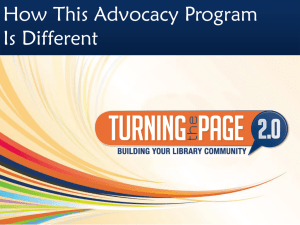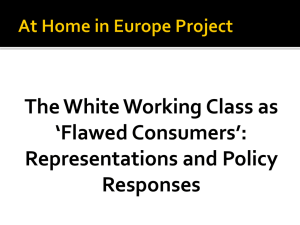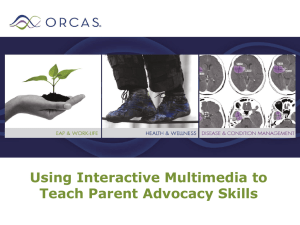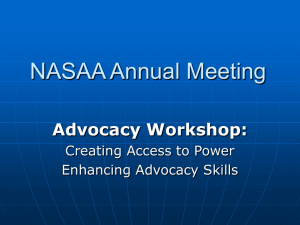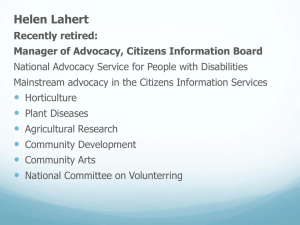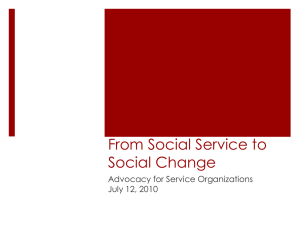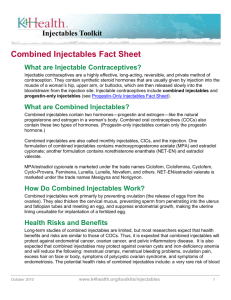Outcomes-Driven Advocacy - Advance Family Planning
advertisement
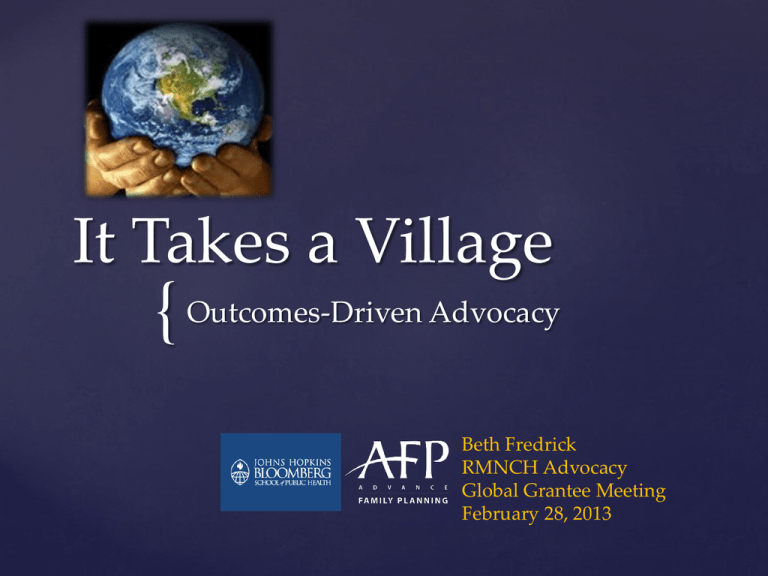
It Takes a Village
{ Outcomes-Driven Advocacy
Beth Fredrick
RMNCH Advocacy
Global Grantee Meeting
February 28, 2013
Reflects the limited research capacity found in the countries in
which AFP works, especially at the district level
Tracks process, outcome and, when possible, impact variables
Provides continuous feedback to advocates in order to improve
advocacy outcomes
Is simple and inexpensive to use
Helps to determine post-project sustainability of advocacy efforts
M&E Approach
Establishes a baseline and benchmarks for assessing progress
Places evidence in a policy context
Incorporates the Smart Chart™ in sharing advocacy priorities
Includes leadership profiles
Will be updated quarterly
Can be adapted to a dashboard presentation
Landscape Assessment
Supports ongoing monitoring of advocacy efforts and decision-making
Graphically captures key inputs, outputs and outcomes
Is designed to contribute to and use other FP2020 accountability mechanisms
Focuses on a specific “Quick Win”
Helps to determine and share effective tactics and messages
Acknowledges contributions of multiple actors, including policymakers
Can be easily updated as the policy environment changes or policies are implemented
Results Cascade
Follows the Smart Chart™
Provide more context and qualitative information on advocacy
“Quick Wins”
Support the Results Cascades
Can include graphic presentation of evidence and/or photographs
Enable full attribution to advocacy partners and policymakers
Case Studies
II want to see it
for myself.
How can we
translate evidence
to action?
What next?
Nakaseke, Uganda Field Visit—July 2010
Uganda: Quick Win – Community Access to Injectables
Ministry of Health (MOH) guidelines enable village health workers (VHWs) to provide contraceptive
injectables
Family Health International (FHI 360), Advance Family Planning (AFP), Partners in Population
and Development African Region (PPD ARO) lead development of strategy with objective of
convening MOH Senior Management Team (SMT) for guidelines review
Evidence on safety and
feasibility of community-based
distribution of injectables
collected and policy brief
prepared (May 2010)
MOH SMT meets on
guidelines (September 2010)
Government officials engaged
at district and central
government level to gain
support and prepare for SMT
presentation on feasibility and
effectiveness (June 2010)
Policy Task Force approves
guidelines (November 2010)
Director General, Health Services
validates the operations research
with his own field visit and
interviews with VHWs) Clinical
Officers and women (July 2010)
MOH Issues guidelines
(January 2011)
Quick win: MOH guidelines authorize the approximately 200,000 VHWs
to provide injectables (March 2011)
Results Cascade
QUICK WIN: Community-based distribution of contraceptive injectables
incorporated into the policy guidelines
Disseminate
New Policy
Guidelines
Train Village
Health
Workers
to Provide
Injectables
Increase
Availability of
Injectables
from VHTs
Increased
Contraceptive
Use
Indonesia Quick Win
Pontianak government increased the 2012 FP budget
31% for over the 2011 budget
Established District Working Group (DWG)
in Pontianak. (November 2010)
DWG develops advocacy
strategy with Smart
Chart™, Netmapping,
Spitfire, and reproductive
health costing.
(November 2010)
DWG partners with BKKBN
and Bappeda to design
programs/budgets to be
discussed at district budget
planning meeting.
(April 2011)
DWG holds round table
discussion with Mayor, Bappeda,
and other stakeholders to build
confidence to invest in family
planning. (May 2011) .
The Mayor, the most critical champion for the district budget increase, expresses full support for
family planning, hoping that Pontianak City will win the family planning top award (based on
number of acceptors). (May 2011)
QUICK WIN: 2012 Pontianak district budget increases by more than 30% over 2011 level
(45,000 USD in 2011 to 59,000 USD). (November 2011)
Results Cascade
QUICK WIN: 2012 Pontianak district budget increases by more than
30% over 2011 level (45,000 USD in 2011 to 59,000 USD).
(November 2011)
Increase funds for community
mobilization, promotion
and advocacy (1)
Improve services for FP
including a dedicated room
for sterilization (2)
Increase budget
for sterilizations (3)
Data will be collected to measure increased availability of methods and FP adoption and
switching
Increased use of
LAPMs in Pontianak
The 2012 World Development Report (WDR) neglected to include a reproductive health
strategy under its gender empowerment section (July 2011)
AFP partners sent letters to the
World Bank’s Executive
Directors and President
emphasizing the links between
family planning and economic
development and gender
empowerment (July 2011)
AFP partners met with the
U.K. World Bank Executive
Director, Suzanna
Moorhead (facilitated by the
Bretton Woods Project,
August 2011)
IPPF engaged in
advocacy with the World
Bank – holding them
accountable for their
commitments in the
Reproductive Health
Action Plan (August
2011)00
The Bank Executive Directors called an emergency meeting with Bank staff
requesting inclusion of family planning in the WDR (August 2011)
The 2012 WDR published and the emphasis on increasing women’s control over
fertility now threads through the WDR 2012 (October 2011)
The “Quick Win” is a misnomer
The “cause and effect conundrum”
Proper attribution
Taking the long view
More work needed to evaluate networks and ongoing activities
Challenges
Taking time to document
Keeping momentum going
A Final Thought
on the Value of Advocacy
Advance Family Planning
www.advancefamilyplanning.org
Beth Fredrick—Bfredric@jhsph.edu
For More Information


